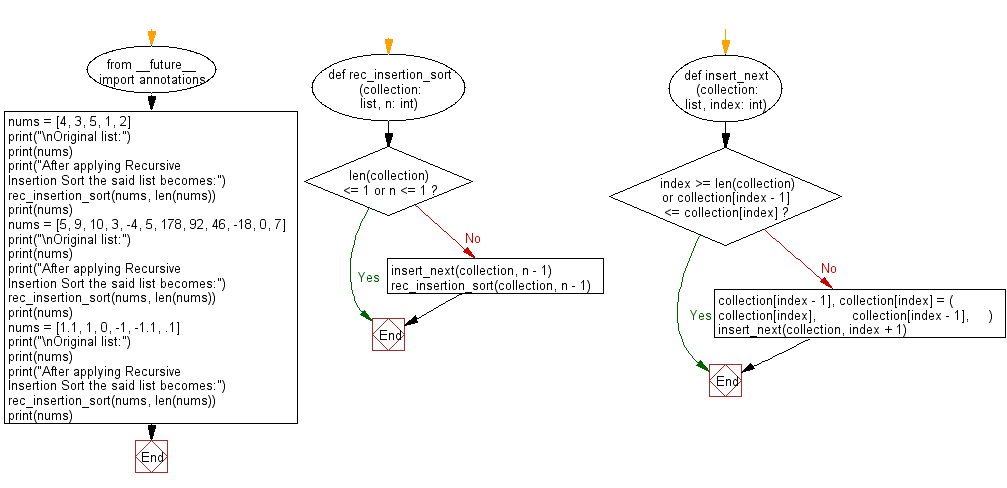Python: Sort a given collection of numbers and its length in ascending order using Recursive Insertion Sort
29. Recursive Insertion Sort
Write a Python program to sort a given collection of numbers and their length in ascending order using Recursive Insertion Sort.
Sample Solution:
Python Code:
#Ref.https://bit.ly/3iJWk3w
from __future__ import annotations
def rec_insertion_sort(collection: list, n: int):
# Checks if the entire collection has been sorted
if len(collection) <= 1 or n <= 1:
return
insert_next(collection, n - 1)
rec_insertion_sort(collection, n - 1)
def insert_next(collection: list, index: int):
# Checks order between adjacent elements
if index >= len(collection) or collection[index - 1] <= collection[index]:
return
# Swaps adjacent elements since they are not in ascending order
collection[index - 1], collection[index] = (
collection[index],
collection[index - 1],
)
insert_next(collection, index + 1)
nums = [4, 3, 5, 1, 2]
print("\nOriginal list:")
print(nums)
print("After applying Recursive Insertion Sort the said list becomes:")
rec_insertion_sort(nums, len(nums))
print(nums)
nums = [5, 9, 10, 3, -4, 5, 178, 92, 46, -18, 0, 7]
print("\nOriginal list:")
print(nums)
print("After applying Recursive Insertion Sort the said list becomes:")
rec_insertion_sort(nums, len(nums))
print(nums)
nums = [1.1, 1, 0, -1, -1.1, .1]
print("\nOriginal list:")
print(nums)
print("After applying Recursive Insertion Sort the said list becomes:")
rec_insertion_sort(nums, len(nums))
print(nums)
Sample Output:
Original list: [4, 3, 5, 1, 2] After applying Recursive Insertion Sort the said list becomes: [1, 2, 3, 4, 5] Original list: [5, 9, 10, 3, -4, 5, 178, 92, 46, -18, 0, 7] After applying Recursive Insertion Sort the said list becomes: [-18, -4, 0, 3, 5, 5, 7, 9, 10, 46, 92, 178] Original list: [1.1, 1, 0, -1, -1.1, 0.1] After applying Recursive Insertion Sort the said list becomes: [-1.1, -1, 0, 0.1, 1, 1.1]
Flowchart:

For more Practice: Solve these Related Problems:
- Write a Python program to implement recursive insertion sort and print the partially sorted list at each recursion level.
- Write a Python script to sort a list of numbers using recursive insertion sort and then output the number of recursive calls made.
- Write a Python program to modify recursive insertion sort to sort a list of tuples based on the length of each tuple.
- Write a Python function to implement recursive insertion sort and then compare its result with an iterative version on the same dataset.
Go to:
Previous: Write a Python program to sort unsorted numbers using Recursive Quick Sort.
Next: Write a Python program to sort unsorted numbers using Recursive Bubble Sort.
Python Code Editor:
Contribute your code and comments through Disqus.
What is the difficulty level of this exercise?
Test your Programming skills with w3resource's quiz.
